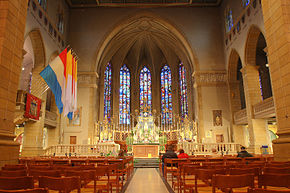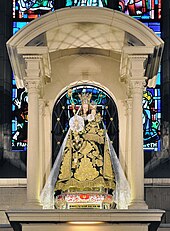Cathedral of Our Lady (Luxembourg)
The Cathedral of Our Lady of Luxembourg ( Luxembourgish Kathedral Notre-Dame , French Cathédrale Notre-Dame de Luxembourg ) is a Roman Catholic place of worship in the city of Luxembourg and the cathedral church of the Archdiocese . The Luxembourgers also refer to the church as Mariendom ( Luxembourgish Mariendoum ).
history
It was built at its current location as a Jesuit church, the foundation stone was laid in 1613. In 1794, the church took on the image of the city and state patroness comforter of the afflicted and became the center of the octave of Our Lady . The figure of Mary was previously worshiped in the destroyed, later rebuilt Glacis Chapel . Around 50 years after the final transfer, the Jesuit Church received the title of consecration of the Church of Our Lady . In 1870 Pope Pius IX raised them . to the Cathedral of Our Lady . In 1935 renovations and extensions were carried out.
In 2011 the church served as a backdrop for the feature film The Treasure Knights and the Secret of Melusina .
architecture
Original structure
The building is a remarkable example of the late Gothic , but has various elements and decorations influenced by the Renaissance style and the early Baroque . The historic main facade is located on Rue Notre Dame (north side) and has a magnificent entrance portal (marked 1621), created by the sculptor Daniel Müller († 1623) from Freiberg in Saxony . In the gable is the monumental coat of arms of Archduke Albrecht VII of Habsburg , who was ruler of the Spanish Netherlands at the time of construction , to which Luxembourg belonged at that time. The original choir was adorned with a vault stone with the coat of arms of the Orval abbot Bernard de Montgaillard (1563-1628). He was probably involved financially in the establishment. When the choir was rebuilt (1935), the coat of arms stone was moved as a spoil in the crypt below.
Remodeling in the 20th century
Between 1935 and 1938 the cathedral was extended and enlarged to the south. The new building, which helps shape the silhouette of the fortress city of Luxembourg, was carried out according to the plans and under the direction of the Luxembourg architect Hubert Schumacher .
This extension, which adjoins the two choir bays from 1613 to 1621, shapes the current shape of the old religious order in the appearance of the city both through its spaciousness and through the architectural unity. In this context, it should be emphasized that the redesign of the exterior architecture of the Gothic-style cathedral was a challenge, as it was necessary to reconstruct the church with the surrounding buildings, such as the Atheneum building from the 17th century, the national library , the old refuge of St. Maximin (1751) (now Ministry of Foreign Affairs), as well as the surrounding older residential buildings, to be harmoniously connected. On the west side of the extension, on l'Arc Athenée / Boulevard Roosevelt (see picture), a new portal, the so-called Marienportal, was created. The new choir of the cathedral is accessible here. Before that, inside on the right, there is a staircase leading to the crypt below with the bishops' tombs and the grand ducal crypt.
Furnishing
altar
In the polygonal choir above the bishopric, in an exposed position, the miraculous image Comforter of the afflicted is set up. In front of it is the modern celebration altar. High arched windows designed with colored glass allow the daylight to enter in broken colors. Tapestries adorn the vestibule with biblical scenes. The main nave is supported by a ribbed vault, on the east side there is the grand ducal gallery. Aisles are built to the west and east; the eastern one is both a sacrament and baptistery, the western one houses an altar in honor of St. Joseph and several large candlesticks on which the believers can put candles. The altar areas of both aisles have rich mosaic decorations.
Organs
The cathedral houses two organs : an instrument from Haupt on the west gallery with 84 registers and an instrument from the organ builder Westenfelder with 64 registers on the rear gallery.
- Great cathedral organ
The large cathedral organ goes back in part to an instrument from 1880, which was built by the organ construction company Dalstein and Haerpfer from Boulay-Moselle . This organ was pneumatized in 1921 and expanded in 1929 by the organ building company Haupt from Lintgen . In 1938 the instrument was replaced by a new building by the same organ building company with 84 stops (cone chests) on four manuals and pedal . The instrument has electropneumatic action. From this organ, the west gallery organ could also be played, which was replaced in 1995 by the new building by Georg Westenfelder . The rear organ had 24 registers and is currently in storage.
|
|
|
|
|
|||||||||||||||||||||||||||||||||||||||||||||||||||||||||||||||||||||||||||||||||||||||||||||||||||||||||||||||||||||||||||||||||||||||||||||||||||||||||||||||||||||||||||||||||||||||||||||||||||||||||||||||||||||||||||||||||||||||||||||||||||||||||||||||||||||||||||||||||
-
Pairing :
- Normal coupling :. II / I, III / I, III / II, IV / I, I / P, II / P, III / P, IV / P.
- Super octave coupling :. I / I, II / I, II / II, III / I, III / II, III / III, IV / I, IV / II, IV / III, IV / IV, I / P, II / P III / P
- Sub-octave coupling :. II / I, II / II, III / I, III / I, III / III, IV / I, IV / II, IV / III, IV / IV
- Playing aids : hand registers, a free combination, 3 free pedal combinations, various fixed combinations (including tutti général, tutti without octave couplings), various shelves, 32-fold setting system , crescendo roller .
- Westemporen organ
The Westemporen organ was built in 1995 by the organ building company Westenfelder (Lintgen, Luxembourg). The instrument has 60 registers on four manuals and a pedal. The Spanish trumpet work is a specialty .
|
|
|
|
|
||||||||||||||||||||||||||||||||||||||||||||||||||||||||||||||||||||||||||||||||||||||||||||||||||||||||||||||||||||||||||||||||||||||||||||||||||||||||||||||||||||||||||||||||||||||||||||||||||||||||||||||||||||
- Pair : I / II, III / II, IV / II, I / P, II / P, III / P, IV / P
- Playing aids :
Bells
The chiming of the cathedral consists of eleven church bells . When the cathedral burned in 1985, only the big bell, the so-called Christ the King Bourdon , was spared from the flames. The big bell was cast by the Ulrich bell foundry in Apolda in 1937 and hangs in the east tower.
In 1986, the Karlsruhe bell and art foundry cast ten new bells. The four smallest bells hang together with the large bell in the east tower; the other bells hang in the west tower.
|
No. |
Surname |
Casting year |
Foundry, casting location |
Diameter (cm) |
Mass (kg) |
Percussive ( HT - 1 / 16 ) |
Bell chamber |
| 1 | Christ the King Bourdon | 1937 | Bell foundry Ulrich , Apolda | a 0 | East tower | ||
| 2 | Mother of God Bourdon | 1986 | Karlsruhe bell and art foundry | 168.5 | 3040 | h 0 | West tower |
| 3 | Joseph | 137 | 1740 | d 1 | West tower | ||
| 4th | Kunigunde | 122.7 | 1260 | e 1 | West tower | ||
| 5 | Benedict | 109 | 875 | f sharp 1 | West tower | ||
| 6th | Elisabeth | 95.2 | 592 | a 1 | West tower | ||
| 7th | Yolanda | 84.8 | 420 | h 1 | West tower | ||
| 8th | Peter | 79.6 | 383 | d 2 | East tower | ||
| 9 | Willibrord | 71.2 | 247 | e 2 | East tower | ||
| 10 | Ignatius | 63.1 | 191 | f sharp 2 | East tower | ||
| 11 | Nicholas | 53 | 140 | a 3 | East tower |
The crypt as a burial place
In the crypt of the cathedral are the tombs of the bishops from the Archdiocese of Luxembourg and the grand ducal family. In addition to the religious dignitaries, the following people are buried here:
- Johann , King of Bohemia (August 10, 1296 - August 26, 1346)
- Maria-Adelheid , Grand Duchess of Luxembourg (June 14, 1894 - January 24, 1924)
- Maria Anna of Portugal , Grand Duchess of Luxembourg (July 13, 1861 - July 31, 1942) - (Wife of Grand Duke William IV )
- Felix von Bourbon-Parma (October 28, 1893 - April 8, 1970) - (Consort of Grand Duchess Charlotte )
- Charles, Prince of Luxembourg (1927–1977) - (Brother of Grand Duke Jean )
- Charlotte , Grand Duchess of Luxembourg (January 23, 1896 - July 9, 1985)
- Joséphine Charlotte of Belgium , Grand Duchess of Luxembourg (October 11, 1927 - January 10, 2005) - (Wife of Grand Duke Jean )
- Jean , Grand Duke of Luxembourg (January 5, 1921 - April 23, 2019)
literature
- The Cathedral of Our Lady of Luxembourg. Schnell Art Guide No. 2200, Schnell & Steiner Verlag, Regensburg, 1995, ISBN 3-7954-4033-5 .
Web links
- Site of the cathedral
- Website of the Catholic Church in Luxembourg / Église catholique à Luxembourg
- Cathedral inscriptions
Individual evidence
- ↑ a b Faith, love, hope. Solemn opening prayer introduces the Octave of Our Lady in the Mariendom. In: Luxemburger Wort , daily newspaper of April 22, 2013; editorial
- ^ Voices from Maria-Laach , Volume 58, Herder Verlag, Freiburg, 1900, p. 58; (Detail scan)
- ↑ More information on the large cathedral organ
- ↑ More information on the Westenfelder organ ( memento of the original from September 27, 2009 in the Internet Archive ) Info: The archive link was inserted automatically and has not yet been checked. Please check the original and archive link according to the instructions and then remove this notice.
- ↑ Sound recording of the carillon and the bells with information about the ringing bells
Coordinates: 49 ° 36 '34.7 " N , 6 ° 7' 52.7" E










